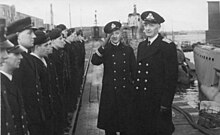Elias Corneliussen
Elias Corneliussen (born August 3, 1881 in Kristiania ; † April 5, 1951 in Tønsberg , Vestfold ) was a Norwegian Rear Admiral of the Navy (Kongelige Norske Marine) , who was most recently Commander of the Navy (Sjef for Marinen) from 1941 to 1946 and 1946 for was for a short time Commander in Chief of the Norwegian Armed Forces (Forsvarssjef) .
Life
Training and employment as a naval officer
Corneliussen, son of the school inspector Andreas Martin Corneliussen and his wife Clara Thinn, grew up in Kristiania and after graduating from secondary school in 1896 , he was hired on a ship with which he went to Great Britain as a cabin boy, junior and ordinary seaman . In 1899 he began his officer training at the Naval War School (Sjøkrigsskolen) , which he completed in 1905. Immediately afterwards he was already in command of a torpedo boat and was then on a long voyage between 1906 and 1908, before he was head of the seamanship school in Fredrikstad from 1908 to 1909 on his return . This was followed by a service in the naval department of the War Ministry between 1909 and 1913 and from 1913 to 1922 as an inspection officer and teacher at the Naval War School. He then found a job in the 1st Maritime District Command between 1922 and 1933, where he was, among other things, head of the mine-laying department from 1928 to 1929, as well as adjutant to King Haakon VII between 1928 and 1931 and, most recently, in 1932, the commander of the coastal armored ship KNM Norge .
Following his promotion to Frigate Captain (Kommandørkaptein) between 1934 and 1937 , Corneliussen was initially head of a department in the Admiralty's staff and, after his promotion to Captain at Sea (Kommandør), from 1937 to 1940 head of the Admiral's staff.
World War II and post-war period
After the German Wehrmacht invaded Norway on April 9, 1940 , he followed King Haakon VII and the Norwegian government to London . There he was promoted to Rear Admiral in 1941 and took over from Rear Admiral Henry this as Commander of the Navy (Sjef for Marinen) , which he held until his replacement by Rear Admiral Thore Horve in 1946. During his exile in Great Britain , he worked on the major challenges relating to the organizational and administrative structure of the Navy and its operational planning. The Navy was given high priority in budgeting and human resource allocation on the Norwegian external fronts. Because of his great effort, he was able to convince Great Britain and the USA to equip the Norwegian Navy with several ships. The result was a sharp increase in the number of ships and crews that resulted in the naval forces participating in a variety of challenging military operations along the Norwegian coast and elsewhere on behalf of the Allies. In particular, there was close cooperation with the Royal Navy .
Due to his extensive experience during the war, Corneliussen also developed plans for the future structure and operational missions of the Navy. This ultimately led to a fleet plan drawn up by him in 1944, which provided for a more powerful navy with larger ships for use on open coastal waters and on the high seas instead of the navy, which had previously been equipped with small ships for coastal protection. Although these plans were later revised, his fleet plan formed the basis for shaping the navy in the post-war period.
On January 1, 1946, Rear Admiral Corneliussen succeeded Lieutenant General Otto Ruge as Commander in Chief of the Norwegian Armed Forces (Forsvarssjef) . However, he practiced this post only a few months until his retirement on May 31, 1946, whereupon he was replaced on June 1 by Major General Halvor Hansson . Nonetheless, he took part in an advisory capacity in the plans to reorganize the naval forces. In 1948 he became a star in command of the St. Olav Order .
On June 20, 1908, he married Dagny Ree, with whom he was married until his death.
Web links
| personal data | |
|---|---|
| SURNAME | Corneliussen, Elias |
| BRIEF DESCRIPTION | Norwegian rear admiral |
| DATE OF BIRTH | August 3, 1881 |
| PLACE OF BIRTH | Kristiania |
| DATE OF DEATH | April 5, 1951 |
| Place of death | Tonsberg , Vestfold |
